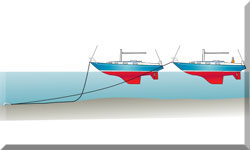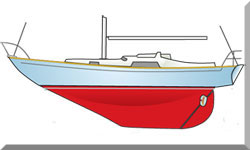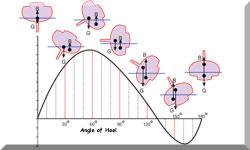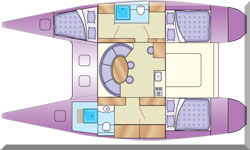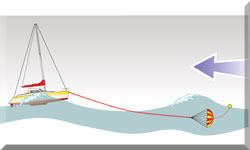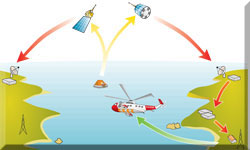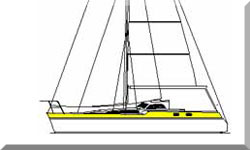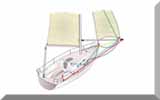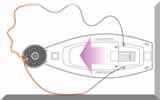- Home
- Electronics & Instrumentation
- Correct VHF Radio Procedure
- Is Marine SSB Still Used
Is Marine SSB Still Used?
and other SSB-related questions
Yes, marine SSB (Single Sideband) radios are still in use, particularly among long-distance sailors and cruisers. While satellite communication has become more popular due to its convenience and reliability, SSB remains a cost-effective option for long-range voice communication and accessing weather updates.
It is especially favoured in remote regions where satellite coverage might be limited. Additionally, SSB is mandatory for certain races, like the Golden Globe Race, due to its reliability in emergencies.
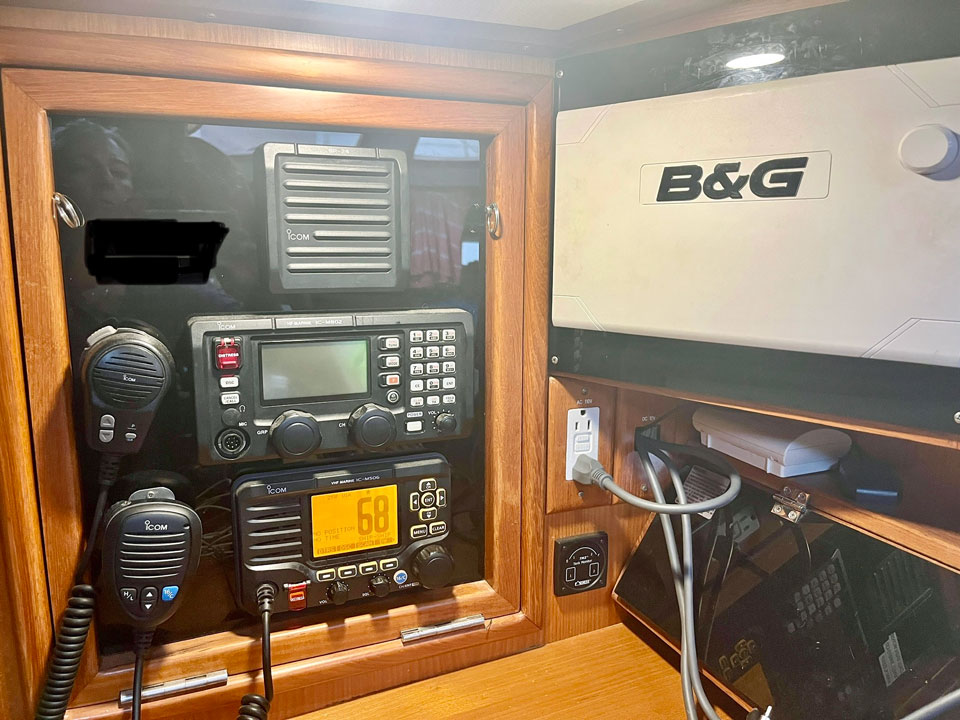 Top Comms: An ICOM SSB IC-M801E and ICOM VHF IC-M605
Top Comms: An ICOM SSB IC-M801E and ICOM VHF IC-M605Your SSB Questions Answered...
What are the pros and cons of different types of SSB antennas for sailboats (e.g., insulated backstay, whip antenna, active antenna)?
What are the pros and cons of different types of SSB antennas for sailboats (e.g., insulated backstay, whip antenna, active antenna)?
When you're picking an SSB antenna for your sailboat, there are a few main types to consider, each with its own pluses and minuses.
- An insulated backstay antenna is pretty popular because it uses something you already have – your backstay – as the antenna. The good thing is that it's out of the way and doesn't add another big stick to your boat. However, the length might not be ideal for all frequencies, and you absolutely have to make sure it's properly insulated from the rest of your rigging.
- A whip antenna is a more traditional-looking vertical antenna. They can be very effective, especially if they're a good length for the frequencies you want to use. The downside is that they're another piece of equipment to mount, and you need to find a good place for it that's away from other metal and won't get in the way.
- Active antennas are smaller, broadband antennas that use electronics to boost the received signal. They can be great for receiving, especially in situations where a longer antenna isn't practical. However, they usually don't transmit very well, so they're more for listening than talking.
When you're deciding, you'll want to think about how much space you have, what frequencies you use most, and whether you're more concerned with transmitting or just receiving.
What are the best frequencies and times of day for specific types of communication (e.g., weather forecasts, cruising nets, long-distance calls)?
What are the best frequencies and times of day for specific types of communication (e.g., weather forecasts, cruising nets, long-distance calls)?
So, when it comes to figuring out the best radio frequencies and times to chat or listen for weather, it's all about how those radio waves bounce around up in the sky. Think of it like this: lower frequencies, in the 2 to 6 MHz range, tend to work best at night and for shorter distances, maybe a few hundred miles. They don't get soaked up by the atmosphere as much when the sun's down.
Then you've got the middle frequencies, like 8 to 12 MHz. These can be good for medium to longer distances, say a few hundred to over a thousand miles, and they often work during the day and into the night too.
For really long hauls, over a thousand miles, the higher frequencies, like 16 to 22 MHz, usually do the trick, but mostly during daylight hours.
Now, for specific things like weather forecasts, there are often set frequencies and times that different services use. You'll need to do a little digging to find out which ones are used in your cruising area, like NOAA in the States or maybe Volmet. They usually publish schedules.
Cruising nets are similar; they have their favourite frequencies and times where everyone checks in. You can usually find this info in cruising guides or by asking around the cruising community.
If you're trying to make a long-distance call, whether it's voice or using something like Pactor for email, you'll have to play around with frequencies a bit depending on the time and how far you're trying to reach.
There's no magic number, so getting a feel for how things work and checking frequency guides is key.
What are the proper protocols and etiquette for participating in SSB radio nets?
What are the proper protocols and etiquette for participating in SSB radio nets?
When you jump into an SSB radio net, there are a few unwritten rules to keep things running smoothly. First off, always listen before you start talking! Make sure no one else is already using the frequency. And when you do call out, start with low power and only crank it up if you're not being heard.
It's good manners to clearly say who you're trying to reach and who you are, like "Calling SeaNet, this is Sailing Vessel Serenity." If the signal's a bit fuzzy, using the phonetic alphabet – you know, Alpha, Bravo, Charlie – can really help avoid mix-ups.
Speak at a normal pace and try to be clear. Think about what you want to say before you press the transmit button, and keep it to the point. When you're done talking, give a little pause so others have a chance to jump in.
If you end up having a longer chat with someone, it's polite to agree to switch to a different, clear frequency so you don't hog the main net. Just be respectful to everyone on the air. If the person running the net gives instructions, let them know you heard and understood.
And finally, it's common to say "Over" when you're done talking and expect a reply, and "Out" when you're finished and don't need one.
How can I optimize my SSB radio's performance for long-range communication?
How can I optimize my SSB radio's performance for long-range communication?
Getting the best performance out of your SSB for those long-distance chats involves a few key things. Your antenna setup is super important. You'll want an antenna that's made for marine SSB, like an insulated backstay or a long whip.
Make sure it's installed right and all the connections are clean and tight. An antenna tuner, whether it's automatic or manual, is a must-have. It helps match your antenna to the radio across different frequencies, which means you get the most power out.
And don't forget about grounding! Especially on fiberglass boats, you need a good, low-resistance connection to the water, often using a copper ground plane linked to underwater metal parts or a special ground plate. For metal boats, the hull itself usually acts as the ground. Another big thing is cutting down on electrical noise from stuff on your boat – engines, generators, LED lights, all that can create interference.
Try turning things off one by one to find the noisy culprits and then look into ways to suppress that noise, like using shielded cables or those little clamp-on things called ferrite chokes. Mounting your SSB antenna as far away as possible from these noisy bits also helps.
When you're actually using the radio, start with the lowest power that gets you heard. You also need to make sure you're using the right mode, usually USB for frequencies above 10 MHz and LSB for below. And sometimes, you might need to fine-tune the received signal with the clarifier knob.
Finally, just being in an open spot, away from obstructions, can help your signal, and understanding a little about how radio waves travel can guide you in picking the best frequencies and times to try and connect.
How do I effectively use a Pactor modem for email and weather data transfer over SSB?
How do I effectively use a Pactor modem for email and weather data transfer over SSB?
Using a Pactor modem to send emails and get weather info over SSB takes a bit of setting up, but it's a lifesaver offshore. You'll need an SSB radio, the Pactor modem itself (like an SCS model), and a computer with the right software, like Airmail or Winlink Express.
First, you install the software and tell it your callsign, email address if you're using one of those services, and the type of modem you have. Then you connect your radio to the modem with audio cables and usually a control cable for things like changing frequencies.
Making sure your SSB antenna is well-tuned for the frequency you're using for data is really important. When you want to connect, you pick a clear frequency in the right band for the time and distance. If you're using Sailmail or Winlink, your software will help you choose a shore station based on how the signals are likely to travel. Then you just hit connect.
If you're talking directly to another boat with Pactor, you both need to agree on a frequency. Once you're connected, the software handles sending and receiving your emails or weather files. Pactor modems are pretty clever; they use error correction and data compression to try and get the best speed even with weak signals. Just remember that SSB isn't super fast, so keep your file sizes reasonable.
And sometimes it takes a little patience to get a good connection, especially if the signal isn't strong. If you're having trouble connecting, double-check your antenna tuning, radio settings, modem setup, and software. Getting a signal report from the other station can also help you figure out what's going wrong.
What are the differences and best uses for voice communication versus digital modes (like Pactor) on SSB?
What are the differences and best uses for voice communication versus digital modes (like Pactor) on SSB?
Voice communication on SSB is great for some things, while digital modes like Pactor shine in others.
With voice, you can have a real-time conversation, which is really handy for quick chats and especially for safety calls like Pan Pan or Mayday. It's also how cruising nets build that sense of community. Plus, most SSB radios have voice capability built in.
The downside is that voice signals can get really messy with noise and interference, and if you're talking to someone who doesn't speak your language well, it can be tough. Also, trying to explain complicated stuff or long lists over voice can be a pain, and it's not exactly private.
Digital modes like Pactor, on the other hand, are much more reliable when the signal is weak or noisy because they use error correction. They can also squeeze more information into a shorter time using compression, and they're super accurate for sending things like emails or weather files without any mistakes.
Plus, the computer can do a lot of the work automatically. The catch is that you need a separate Pactor modem, which costs extra, and setting everything up can be a bit more complicated than just talking. It's also not really for having a casual back-and-forth chat.
Most experienced cruisers end up using both voice and digital modes, picking the best tool for the job at hand.
What are the common causes of poor signal strength or inability to receive transmissions on my SSB radio?
What are the common causes of poor signal strength or inability to receive transmissions on my SSB radio?
If you're struggling to hear anything or your signal is weak on your SSB, there are a few common culprits. One big one is if your antenna isn't properly tuned for the frequency you're trying to listen to. Your antenna itself could also be the problem – maybe there's corrosion on the connections, the wire is damaged, or a connection has come loose.
If you have a fiberglass boat, a poor or missing ground connection can really hurt your reception. And then there's all the electrical noise that can come from other things on your boat, like your engine or LED lights, which can just drown out the signals you're trying to hear. Of course, the way radio waves travel can be unpredictable, so sometimes it's just atmospheric conditions or interference from other people transmitting nearby.
It's also possible, though less common, that there's an issue with the radio's receiver itself. And don't forget to double-check that you're on the right mode (USB or LSB) and the exact frequency the other station is using.
Finally, the station you're trying to hear might just have a weak signal or be too far away at that particular time. When you're trying to figure out what's wrong, it's best to go through these possibilities one by one, starting with the most likely things like antenna connections and noise.
How can I diagnose and eliminate sources of electrical noise on my boat that interfere with SSB reception?
How can I diagnose and eliminate sources of electrical noise on my boat that interfere with SSB reception?
Tracking down and getting rid of electrical noise that's messing with your SSB reception can be a bit like detective work. Start by really listening to the noise in your receiver. Is it a constant whine, a buzzing sound, or maybe intermittent clicks? That can give you a clue about where it's coming from. Then, systematically turn off different electrical systems and pieces of equipment on your boat while you listen to your SSB.
When the noise goes away or gets much quieter, you've probably found the source. Some common noisy things on boats include the engine alternator, inverters and battery chargers, some LED lights, the power supplies for electronics, and even things like GPS units or computer gear.
Once you've identified the noisy stuff, there are ways to try and fix it. Using shielded cables for power and signal wires can help, especially if you make sure the shield is properly grounded at one end. Those little clamp-on things called ferrite chokes can also be really effective at blocking RF interference when you put them around power cables and signal wires. For some devices, you might be able to install DC power line filters.
Making sure everything on your boat is properly grounded to a common point can also help prevent noise from ground loops. Sometimes, just moving your SSB antenna and radio as far away as possible from the noisy equipment can make a big difference. And it's always worth checking the manuals for your electronic devices, as they might have specific advice on how to reduce noise.
How do I test my SSB radio and antenna system to ensure it's functioning correctly?
How do I test my SSB radio and antenna system to ensure it's functioning correctly?
To make sure your SSB radio and antenna are working as they should, it's a good idea to do some regular checks. Many radios have built-in self-test functions that can check the basics. You can also try tuning into known strong broadcast stations, like time signals or weather broadcasts. If you can hear them clearly, that's a good sign your receiver is generally okay. If you have a dummy load – which is basically a fake antenna that doesn't transmit – you can connect that and briefly transmit to test your radio's power output without causing interference.
You'd use a power meter to see if it's putting out the expected amount of power. Just never transmit without an antenna or a dummy load connected, as that can damage your radio. A really useful way to check how you're getting out is to contact a shore station, a cruising net controller, or another boat that you know has a good SSB setup and ask them for a signal report. They can tell you how strong and clear your signal is.
An SWR meter is another handy tool. It measures how well your radio and antenna are matched. A low reading is good, while a high reading suggests you might have antenna tuning issues, grounding problems, or damage to your antenna.
Finally, just give your antenna, all the connections, and the wiring a good visual check every now and then for any signs of corrosion, damage, or loose bits. If you're using Pactor, try connecting to a known good station every so often to make sure your modem and software are still working correctly.
What maintenance is required for an SSB radio and its components (antenna, tuner, connections) in a marine environment?
What maintenance is required for an SSB radio and its components (antenna, tuner, connections) in a marine environment?
Living on a boat in a saltwater environment is tough on electronics, so a little maintenance goes a long way for your SSB gear. For the radio itself, the most important thing is to keep it dry. Install it in a spot where it won't get splashed or damp, or use a waterproof cover.
The power and antenna connectors can get corroded, so cleaning them periodically with a contact cleaner can prevent problems. Also, just make sure all the cables are plugged in securely. Your antenna also needs some attention. Regularly check the wire or whip for any damage, kinks, or breaks. The insulators on the antenna can get coated in salt, which can affect performance, so give them a wipe down now and then.
All those connections in the antenna system – where the antenna wire connects to insulators, where the coax cable connects to the antenna and the tuner – are prime spots for corrosion, so keep an eye on them and clean them if you see any build-up. The antenna tuner is usually pretty robust, but make sure its connections are also clean and tight.
And that all-important ground connection needs to be checked regularly to make sure it's still solid and free from corrosion. If you have a ground plate, make sure it's clean. Basically, keeping everything clean, dry, and with tight, corrosion-free connections is the name of the game for making your SSB system last.
How do I properly ground my SSB radio system on a fiberglass or metal hull sailboat?
How do I properly ground my SSB radio system on a fiberglass or metal hull sailboat?
Getting a good ground for your SSB radio is crucial, especially if you have a fiberglass hull. Since fiberglass doesn't conduct electricity, you need to create an artificial ground. The most common way is to use a copper ground plane, which is basically a network of copper foil or wires that you bond to underwater metal fittings like your keel bolts or through-hulls.
Another option is to install a sintered bronze ground plate specifically designed for this purpose. The key is to make sure you have a large surface area in contact with the seawater to provide a low-resistance path. Then, you need to run a heavy-gauge wire from your antenna tuner's ground terminal to this ground plane or plate, making sure all the connections are clean and really tight to prevent corrosion.
On a metal hull sailboat, the hull itself acts as a natural ground plane, which is a big advantage. In this case, you still need to make sure your antenna tuner is securely bonded to the hull with a good, solid connection. Regardless of whether you have a fiberglass or metal boat, a poor ground can lead to weak signals, high SWR, and even damage to your radio, so it's worth getting it right.
What are the power requirements of an SSB radio, and how do I ensure I have an adequate and clean power supply?
What are the power requirements of an SSB radio, and how do I ensure I have an adequate and clean power supply?
SSB radios can draw a fair amount of power, especially when you're transmitting. Typically, they might draw anywhere from a few amps on receive to 10-20 amps or even more when transmitting at full power. It's really important to check the specifications for your specific radio model to know exactly what it needs.
To make sure you have enough power, you need to consider your boat's electrical system, including the capacity of your batteries and the charging system. You might need a dedicated, heavy-gauge wire run directly from your battery bank to the radio with a fuse close to the battery for safety.
It's also crucial to have a clean power supply, meaning the voltage should be stable and free from excessive noise or voltage drops, especially when transmitting. If your boat's electrical system is prone to voltage fluctuations, you might consider using a voltage regulator or a separate, well-filtered power supply for your SSB radio to ensure consistent performance and prevent damage.
Undersized wiring can also cause voltage drops, so make sure your wiring is thick enough for the current draw and the length of the run.
Do I need a license to operate an SSB marine radio, and what are the requirements?
Do I need a license to operate an SSB marine radio, and what are the requirements?
Yes, in most countries, you do need a license to operate an SSB marine radio, as it transmits on frequencies allocated for maritime use. The specific requirements vary depending on your nationality and the country where your boat is registered. In the United States, for example, you generally need an FCC ship station license for your vessel and a restricted radiotelephone operator permit (RR) for the person operating the radio if you are transmitting internationally or to a foreign port.
For domestic communication within the US, the licensing requirements might be less stringent for recreational boaters, but it's always best to check the current regulations. In the UK, you'll likely need a Ship Radio Licence and possibly an operator's certificate like the Short Range Certificate (SRC) or Long Range Certificate (LRC), depending on the capabilities of your radio equipment.
It's really important to research the specific licensing rules for your country and the countries you plan to visit to ensure you're operating legally. You can usually find this information on the websites of your national telecommunications authority or maritime administration.
What are the essential components of a complete SSB radio system for offshore sailing?
What are the essential components of a complete SSB radio system for offshore sailing?
If you're planning on doing some serious offshore sailing and relying on SSB, there are a few key pieces of equipment you'll want to have. First, you'll need a good quality SSB transceiver – that's the radio itself that can both transmit and receive. Then you'll need a suitable antenna for your boat, whether it's an insulated backstay, a whip antenna, or something else.
To get the best performance from your antenna across different frequencies, an automatic or manual antenna tuner is really essential. And for those times when voice isn't cutting it, especially for getting weather data or sending emails, a Pactor modem is a game-changer.
You'll also need a reliable power supply for your radio, with proper wiring and fusing. Don't forget the cables to connect everything together – the antenna to the tuner, the tuner to the radio, and if you have a Pactor modem, the audio and control cables to your computer.
Finally, having a good understanding of how it all works and maybe some reference materials like frequency charts will round out your essential SSB kit for offshore adventures.
Can I integrate my SSB radio with GPS or other navigation instruments?
Can I integrate my SSB radio with GPS or other navigation instruments?
Yes, you can definitely integrate your SSB radio with GPS and other navigation instruments, and this can be really useful for a few reasons. One common integration is for sending your position reports over digital modes like Pactor.
Some software used with Pactor modems can automatically grab your boat's GPS coordinates from your chartplotter or GPS receiver and include them in your emails or position updates to shore stations or other vessels. This can be a great safety feature.
Another potential integration is for DSC (Digital Selective Calling) capabilities, although SSB DSC isn't as commonly used as VHF DSC. If your SSB radio has DSC, it can be connected to your GPS to automatically include your position in distress calls.
You'll typically need to connect the NMEA 0183 or NMEA 2000 data output from your GPS or other instruments to the corresponding input on your SSB radio or Pactor modem using the appropriate interface cables.
You'll then need to configure the devices to communicate with each other, often through software settings. Integrating your SSB with your navigation instruments can enhance both communication and safety while you're offshore.
How does SSB radio compare to other long-range communication options like satellite phones or satellite internet for offshore sailing?
How does SSB radio compare to other long-range communication options like satellite phones or satellite internet for offshore sailing?
When you're heading offshore and need to stay connected, SSB radio, satellite phones, and satellite internet are the main options, and they each have their own set of trade-offs. SSB has been around for a long time and can be relatively cost-effective once you have the equipment. You can get weather forecasts, participate in cruising nets, and with a Pactor modem, send emails. However, it can be unreliable due to atmospheric conditions, and the data speeds are very slow.
Satellite phones offer more reliable voice communication over long distances, and some can also handle basic data like text messages or low-bandwidth email. They're generally more expensive to use than SSB, with airtime charges. Satellite internet provides much faster data speeds, allowing you to browse the web, send larger emails, and even stream some services, depending on the plan.
However, it typically has the highest upfront equipment costs and ongoing subscription fees. SSB is great for basic communication and weather, especially if you're on a budget. Sat phones are good for reliable voice calls and basic data.
Satellite internet offers the most connectivity but comes at a premium cost. The best choice often depends on your budget, how critical reliable communication is, and what kind of data needs you have while you're offshore. Many long-term cruisers end up using a combination of these technologies to balance cost and capability.
Recent Articles
-
Is Marine SSB Still Used?
Apr 15, 25 02:05 PM
You'll find the answer to this and other marine SSB-related questions right here... -
Is An SSB Marine Radio Installation Worth Having on Your Sailboat?
Apr 14, 25 02:31 PM
SSB marine radio is expensive to buy and install, but remains the bluewater sailors' favourite means of long-range communication, and here's why -
Correct VHF Radio Procedure: Your Questions Answered
Apr 14, 25 08:37 AM
Got a question about correct VHF radio procedure? Odds are you'll find your answer here...

